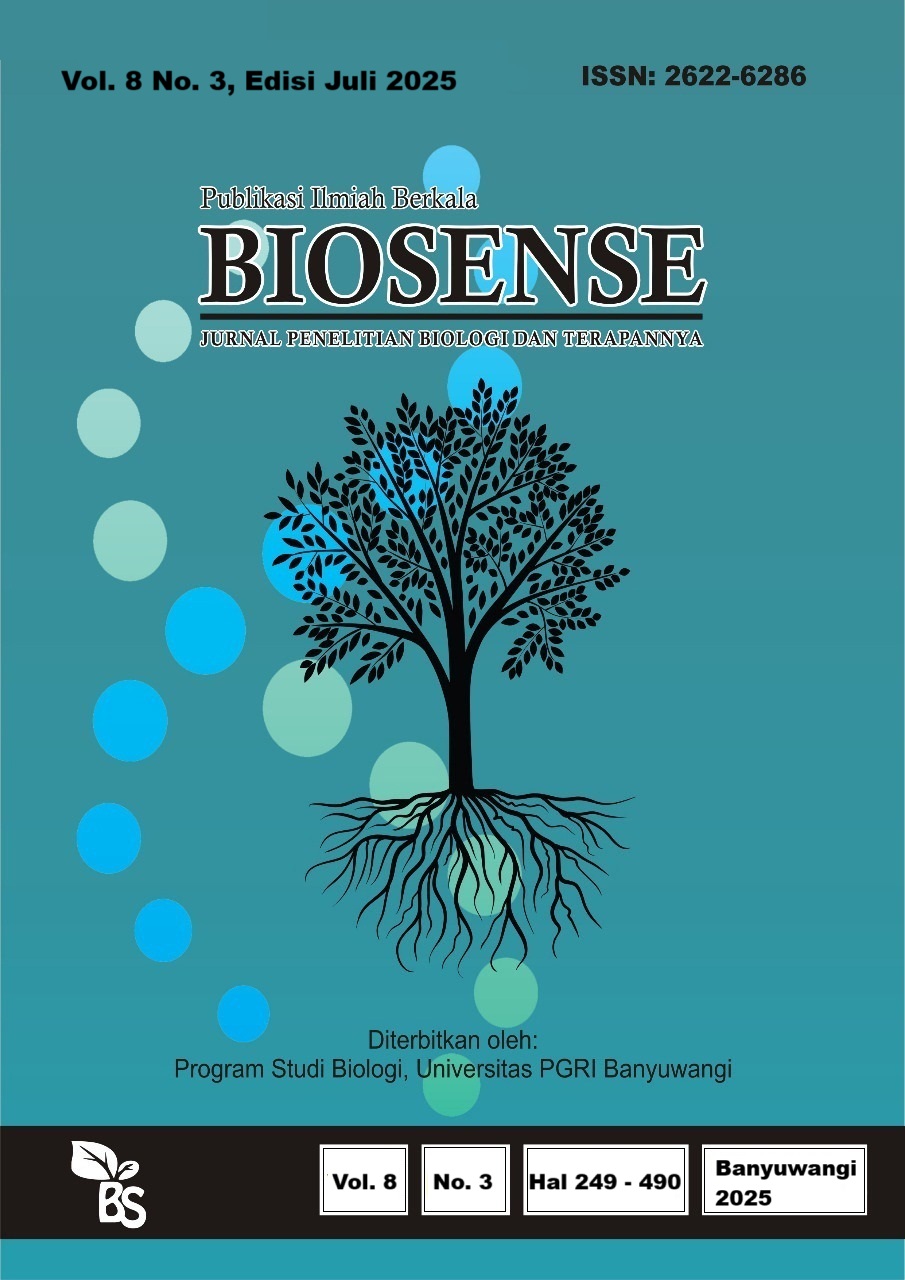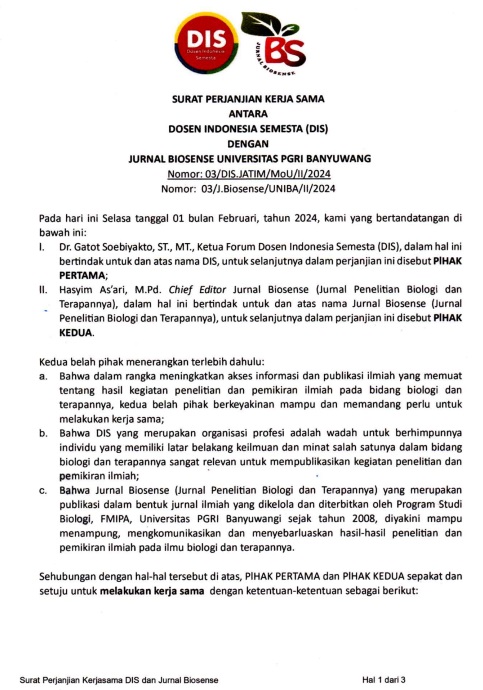RESPON FISIOLOGI IKAN NILA (Oreochromis niloticus) AKIBAT PAPARAN TIMBAL NITRAT (Pb(NO₃)₂) DAN KADMIUM KLORIDA (CdCl2)
DOI:
https://doi.org/10.36526/biosense.v8i3.5419Keywords:
ikan nila, logam berat, timbal, kadmium, hematologiAbstract
Logam berat seperti timbal (Pb) dan kadmium (Cd) merupakan polutan berbahaya yang dapat mengganggu fungsi fisiologis organisme akuatik, termasuk ikan nila (Oreochromis niloticus). Penelitian ini bertujuan untuk mengetahui respon fisiologis ikan nila terhadap paparan Pb(NO₃)₂ dan CdCl₂ pada konsentrasi 1 ppm selama 3 jam. Parameter yang diamati meliputi kecepatan respirasi, morfometrik saluran pencernaan, serta parameter hematologi seperti jumlah eritrosit, leukosit, dan kadar hemoglobin. Hasil menunjukkan bahwa paparan CdCl₂ memberikan efek toksik lebih kuat dibandingkan Pb(NO₃)₂, dengan penurunan signifikan pada jumlah eritrosit, kadar hemoglobin, dan kecepatan respirasi. Sementara itu, paparan Pb(NO₃)₂ juga menyebabkan penurunan hemoglobin dan eritrosit, serta perubahan warna organ pencernaan seperti empedu dan hati, namun efeknya tidak sebesar CdCl₂. Kedua logam berat meningkatkan jumlah leukosit sebagai respons imun terhadap stres oksidatif. Hasil ini mengindikasikan bahwa logam berat, terutama Cd, dapat mengganggu sistem pernapasan, peredaran darah, dan fungsi pencernaan ikan nila.
References
Abdel-Warith, A. W. A., Younis, E. S. M., Al-Asgah, N. A., Abd-Elkader, M. O., & Elsayed, E. A. (2020). Effects of Sub-lethal Lead Nitrate and Copper Sulfate Concentrations on Hematological Parameters During Long-term Exposure in Nile tilapia (Oreochromis niloticus). Journal of Scientific & Industrial Research, 79, 437-441.
Agustina, D. Y., Suprapto, D., & Febrianto, S. (2019). Kandungan Logam Berat Timbal (Pb) Pada Ikan Nila (Oreochromis niloticus) Di Sungai Tenggang, Semarang, Jawa Tengah Heavy Metal Concentration of Pb in Nile tilapia (Oreochromis niloticus) in the Tenggang River, Semarang, Central Java. Management of Aquatic Resources Journal (MAQUARES), 8(3), 242-249.
Akmal, Y., Devi, C. S., Muliari, M., Humairani, R., & Zulfahmi, I. (2021). Morfometrik Sistem Pencernaan Ikan Nila (Oreochromis niloticus) yang Dipapar Limbah Cair Kelapa Sawit. Jurnal Galung Tropika, 10(1), 68–81. https://doi.org/10.31850/jgt.v10i1.736
Álvarez-González, C. A., Martínez-Sánchez, L., Peña-Marín, E. S., Guerrero-Zárate, R., Ramírez, F. J., Morales-García, V., Uribe-López, M., & Núñez-Nogueira, G. (2020). Effects on the Growth and Digestive Enzyme Activity in Nile Tilapia Fry (Oreochromis niloticus) by Lead Exposure. Water Air and Soil Pollution, 231(9), 1–15. https://doi.org/10.1007/S11270-020-04810-9
Aprilliyani, E. P., & Rahayuningsih, M. (2020). Keanekaragaman spesies ikan sebagai bioindikator kualitas perairan di sungai Kaligarang Kota Semarang. Life Science, 9(1), 1-10.
Arisma, D. A., Purnaini, R., & Saziati, O. (2023). Identifikasi Kandungan Logam Berat Kadmium (Cd) pada Ikan Nila (Oreochromis niloticus) di Sungai Kapuas Kecil. Jurnal Teknologi Lingkungan Lahan Basah, 11(1), 117-122.
Begum, S. A., Hasnath, M., & Aziz, K. A. (2024). Cadmium Chloride Induced Histopathological Alterations in the Selected Organs of Nile tilapia Oreochromis niloticus (L.). Bangladesh Journal of Zoology, 52(2), 237-251.
Bobu, F. R. (2022). Respon Potensial Membran Sel Telur Ikan Nila (Oreochromis Niloticus) Akibat Terkontaminasi Timbal (Pb). EduFisika: Jurnal Pendidikan Fisika, 7(1), 47-54.
Chatterjee, S., & Saxena, R. K. (2015). Preferential Elimination of Older Erythrocytes in Circulation and Depressed Bone Marrow Erythropoietic Activity Contribute to Cadmium Induced Anemia in Mice. PLOS ONE, 10(7). https://doi.org/10.1371/JOURNAL.PONE.0132697
Ghaffari, S. (2008). Oxidative stress in the regulation of normal and neoplastic hematopoiesis. Antioxidants & Redox Signaling, 10(11), 1923–1940. https://doi.org/10.1089/ARS.2008.2142
Gupta, S. K., Gupta, R., Nage, S., Kumar, N., Kumari, R., Gupta, A., ... & Krishnani, K. K. (2025). Heavy metal accumulation and biomarker responses of Nile tilapia from a coal void reservoir cage aquaculture system. Journal of Hazardous Materials Advances, 100631.
Hassan, E., El-Sayed, G., E Hassan, A., & Abd Elsalam, S. (2020). Effect of pollution with lead, cupper, cadmium on gene expression pattern of liver GST and serum lysozymes in Nile tilapia (Oreochromis. niloticus). 21(3), 53–60. https://doi.org/10.21608/MVMJ.2020.310
Kaya, H., Akbulut, M., Çelik, E. Ş., & Yilmaz, S. (2013). Impacts of sublethal lead exposure on the hemato-immunological parameters in tilapia (Oreochromis mossambicus). Toxicological & Environmental Chemistry, 95(9), 1554–1564. https://doi.org/10.1080/02772248.2014.895363
Koniyo, Y. (2020). Analisis kualitas air pada lokasi budidaya ikan air tawar di Kecamatan Suwawa Tengah. Jurnal Technopreneur (JTech), 8(1), 52-58.
Naz, H., Ahmed, T., Omran, A. M. E., Alanazi, Y. F., Usman, M., Ijaz, M., Qazi, A. A., Ali, B., Ali, H., & Alasmari, A. (2023). Determination of histological and genotoxic parameters of Nile Tilapia, Oreochromis niloticus exposed to lead (Pb). Cellular and Molecular Biology, 69(4), 7–15. https://doi.org/10.14715/cmb/2023.69.4.2
Oktapiandi, Joko Sutrisno, Sunarto. (2019). Analisis Pertumbuhan Ikan Nila yang Dibudidayakan pada Air Musta’mal. Jurnal Bioeksperimen. Vol. 5 (1) Pp. 16-20. https://doi.org/10.23917/bioeksperimen.v5i1.2795
Panigoro, N., A. Indri., B. Meliya., Salifira., D.C. Prayudha., & Kunika, W. (2017). Teknik Dasar Histologi dan Atlas Dasar–dasar Histopatologi Ikan. Balai Budidaya Air Tawar dan Japan International Coperation Agency (JICA) : Jambi.
Per, P. A. C. T., Kodithu, S. P., Sundara, T. V., & Edirisingh, U. (2015). Bioaccumulation of Cadmium in Freshwater Fish: An Environmental Perspective. 4(1), 1–12. https://doi.org/10.5567/ECOLOGY-IK.2015.1.12
Perera, P. A. C. T., Kodithuwakku, S. P., Sundarabarathy, T. V., & Edirisinghe, U. (2015). Bioaccumulation of Cadmium in freshwater fish. An environmental perspective, Insight Ecol. 4 (1), 1-12. http://dx.doi.org/10.5567/ECOLOGY-IK.2015.1.12
Pradona, S., & Partaya, P. (2022). Akumulasi Logam Berat Timbal (Pb) pada Daging Ikan di Tanjung Mas Semarang. Life Science, 11(2), 143-150.
Purwanto, A. I., Prihatmo, G., & Pakpahan, S. (2020). Kandungan Logam Berat Timbal (Pb) pada Ikan Nila (Oreochromis niloticus) dan Ikan Bawal (Colossoma macropomum) di Sungai Winongo, Yogyakarta. Sciscitatio, 1(2), 70-78.
Rahayu, N. I., Rosmaidar, R., Hanafiah, M., Karmil, T. F., Helmi, T. Z., & Daud, R. (2017). Pengaruh paparan timbal (Pb) terhadap laju pertumbuhan ikan nila (Oreochromis nilloticus). Jurnal Ilmiah Mahasiswa Veteriner, 1(4), 658-665.
Saputri, A., Khairuddin, K., & Yamin, M. (2023). Analysis of Cadmium (Cd) Heavy Metal Content in Mosambique Tilapia Fish (Oreochromis mossambicus) Derived from Rawa Taliwang Lake to Enrich Ecotoxicology Lecture Material in 2022. Jurnal Biologi Tropis, 23(2), 390-397.
Sheethal, K., Nadoor, P., Somashekara, S. R., Suryawanshi, U., Amogha, K. R., Telvekar, P. A., Shelke, S. T., & Pathan, J. G. K. (2024). Physiological Changes in Nickel-exposed Nile Tilapia Oreochromis niloticus during Exposure and Recovery Periods. Journal of Scientific Research and Reports. https://doi.org/10.9734/jsrr/2024/v30i62048
Soegianto, A., Yulianto, B., Payus, C. M., Affandi, M., Mukholladun, W., Indriyasari, K. N., ... & Rahmatin, N. M. (2023). Sublethal Effects of Cadmium on the Osmoregulatory and Acid‐Base Parameters of Tilapia (Oreochromis niloticus) at Various Times. Journal of Toxicology, 2023(1), 2857650. https://doi.org/10.21203/rs.3.rs-1539214/v3
Sweet, L. I., & Zelikoff, J. T. (2001). Toxicology and immunotoxicology of mercury: a comparative review in fish and humans. Journal of Toxicology and Environmental Health-Part B-Critical Reviews, 4(2), 161–205. https://doi.org/10.1080/10937400117236
Vo, VT, Long Le TM, Duong TQA, Mai NAT and Thuong NHT. (2022). Assessment of lead toxicity in red tilapia Oreochromis sp. through hematological parameters. Asian J. Agric. Biol. 2022(2): 202101016. DOI: https://doi.org/10.35495/ajab.2021.01.016.
Xue, Y., Huang, J., Wang, J.-Q., & Li, F.-Y. (2023). Tissue-specific accumulation and depuration of cadmium in tilapia: role of salinity and cadmium concentration. Applied Ecology and Environmental Research. https://doi.org/10.15666/aeer/2105_41774194
Younis, E. M., Abdel-Warith, A. A., Al-Asgah, N. A., Ebaid, H., & Mubarak, M. (2013). Histological changes in the liver and intestine of Nile tilapia, Oreochromis niloticus, exposed to sublethal concentrations of cadmium. Pakistan Journal of Zoology, 45(3), 833-841.
Yulaipi, S., Aunurohim, A. L., Hidayati, D., & Soegianto, A. (2020). Oreochromis mossambicus accumulates lead without showing growth inhibition. Ecology, Environment and Conservation, 26, S36-S40.
Downloads
Published
How to Cite
Issue
Section
License
Copyright (c) 2025 JURNAL BIOSENSE

This work is licensed under a Creative Commons Attribution-NonCommercial-ShareAlike 4.0 International License.

















